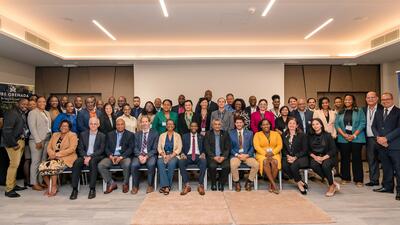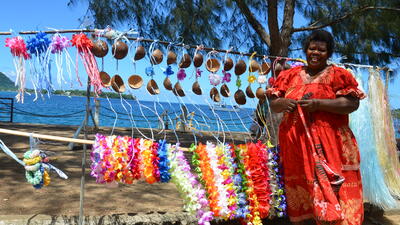New Market Opportunities in Emerging Markets
As the recovery from the global economic crisis unfolds, the role of emerging economies and changing patterns of competition are key to the sustainability of world trade growth. Amidst diversifying markets, changing demographics and consumer-driven demand in developing countries, there is renewed call for multilateralism versus regional trade agreements and the modernization of trade support mechanisms.
World trade contracted by approximately 10% in 2009, but projections suggest it is growing again at a rate of 25%. In Asia, Africa and the Middle East, growth is even stronger at a rate of 35% driven by demand in Asia and increasing commodity prices. In Indonesia exports are growing by 23%, bringing us back roughly to 2008 levels. So the big question is: what will happen beyond 2010? In the post-crisis environment, the new market opportunities are in the emerging economies, especially Asia. Even during the 2009 crisis, developing economies grew by 6.6% and, led by China and India, are expected to grow by 8–10% in the next two years. But it is important not to forget other Asian countries, especially those in South-East Asia. Indonesia, the largest country in the region, had growth rates of 4.5% in 2009 and its growth is expected to reach 6% over the next two years.
Diversification of Markets
The question of how sustainable export and trade growth will be in the coming years is dependent on the diversification of both markets and products. In the sense of market diversification, the big story is the growth of South–South trade and the strengthening of the emerging economies. Since 1990 South–South trade has grown at almost twice the rate of world trade generally. Among developing countries, 39% of trade is with other developing countries. For example, China’s trade with other developing countries is currently 25% of total trade and is expected to reach 50% by 2020 and 60% by 2027. About 50% of Indonesia’s trade is with other developing countries, mainly in East Asia.
An interesting question is why this has happened. In the case of Indonesia, it has been driven by economic integration and the open trade and investment policies we have instigated since 1995 as part of our World Trade Organization (WTO) commitment. China’s accession to the WTO also contributed and the G20 surveillance mechanism during the global economic crisis helped to stem calls for protectionism and unilateral reform agendas as we competed with each other for investment and, finally, regional trade agreements. For Indonesia, the multilateral trading system and the conclusion of the Doha Round are key to ensuring continued South–South trade and an open trade and investment environment. Importantly, the Doha development agenda calls for removing export distortions in agriculture and tariff peaks.
This must be complemented by a comprehensive aid for trade package and a trade facilitation and capacity-building agenda such as that developed by ITC.
Diversification of Products
About 10 to 15 years ago in East Asia we used to talk about the ‘flying geese pattern’ of shifting from one country to another mainly driven by labour costs in the search for lower production costs. But a totally different intra-East Asian trade pattern is now emerging. Trade was once dominated by trade in intermediate goods and services, with exports mainly to developed country markets outside East Asia, but it is now changing to a much more complex pattern of localization and specialization. It is no longer just about lower labour costs, but about the availability of supporting industries and the value added and service components that can be offered. According to some estimates, one-third of world trade is done firm-to-firm not just country-to-country. As policy-makers, we need to focus on issues including how to reduce trade transaction costs and ensure a quality business environment through marketing support institutions and enforcing contracts. This is a call again for multilateralism versus regional trade agreements.
Many Indonesian exporters complain to us about having to deal with ten rules of origin within the 10 plus one Asian agreement. This could be solved with a multilateral trading system based on most favoured nation status, but also with a well-designed regional trade agreement. Harmonizing rules of origin is another solution being tested in East Asia. Obviously, logistics and infrastructure, including ICT infrastructure, is key to integrating small and medium-sized enterprises and getting them into the services supply chain. This is an important component not lost upon a large country like Indonesia where, for example, it is cheaper to import oranges from China than to source them from the Indonesian province of Kalimantan.
Demand for Consumer Goods and Changing DemographicsTwo very important factors need to be considered when looking at the emerging economies and the growth of East Asian trade. Firstly, we are seeing an increasingly consumption-driven market, because we are no longer producing here and exporting, but selling more consumer goods to each other. This dynamic is driven by increased purchasing power from the growing middle-class populations in China, India and Indonesia, which are estimated at, respectively, 290 million people, 100 million and 25 million.
Secondly, the impact of changing demographics: in contrast to China, which is moving towards an ageing population, India and South Asia are expected to see a decrease in the national median age over the next 10 to 15 years. For example, 50% of Indonesia’s population is below 29 years of age. That is why Indonesia is the second largest user of Facebook in the world with 29 million users and the sixth highest user of Twitter. So the way you market in these countries – through social marketing, media and networking – is a phenomenon that needs to be considered.
This article is based on a transcript of Ms Pangestu’s speech at the 2010 World Export Development Forum.











